Degassing of Aluminum Alloy Melts by High Shear Melt Conditioning Technology: An Overview
Abstract
:1. Introduction
2. Origin of Hydrogen and Oxides and the Assessment of Melt Quality
3. High Shear Melt Conditioning Development for Degassing
3.1. Requirements for Achieving an Efficient Degassing
3.2. From the Conventional Rotary Methodology to the Innovative HSMC Degassing Process
3.3. HSMC Process Visualization and Optimization by Water Modeling
3.3.1. Improved Bubble Dispersion and Surface Stability Compared to Rotary Degassing
3.3.2. Effect of Rotor Speed and Gas Flow Rate on the Dispersion of Bubbles by HSMC
4. Applicability of HSMC on Aluminum Melts
4.1. Materials, Degassing, and Casting Procedure
4.2. Faster and More Efficient Removal of Hydrogen and Oxide Bifilms from the Aluminum Melts
5. Effect of HSMC Degassing on Casting Integrity and Mechanical Properties
5.1. Significant Reduction in Porosity Size and Defects in the Castings
5.2. Improved Mechanical Properties with Reduced Variability
6. Toward Implementation of the HSMC Degassing Process in Industry
6.1. Large Scale Batch Processing by HSMC Degassing
6.2. HSMC Degassing in Continuous In-Line Processing Mode
7. Summary
- The principle of High Shear Melt Conditioning for the purpose of degassing aluminum melts prior to casting has been technologically developed during the LiME Hub project, providing an efficient solution to solve the aluminum melt cleanliness problem.
- This novel technology guarantees the removal of hydrogen and oxide bifilms at the same time, with a minimal vortex or surface turbulence, something that eliminates the need for protective covering fluxes and minimizes regassing when processing long afterward.
- The optimal parameters for effective bubble recirculation in liquid have been obtained by physical modeling in water. The effective bubble dispersion provided by the HSMC technology allows for drastically reducing the gas flow rate required, in comparison to conventional rotary degassing units and the needs of extremely high rotor speeds, which also reduces the power consumption and makes the process more efficient.
- When HSMC is applied to aluminum melts, a faster and more effective degassing is achieved compared to rotary degassing, because of the dispersive and distributive flow provided by the HSMC technology. The improved melt quality can be guaranteed for a long time after degassing, eliminating the need for repeated degassing cycles and ensuring that the castings have a consistent reduced porosity and enhanced mechanical properties with reduced variability, which allows the aluminum alloys to be upgraded for high-performance applications.
- The melt quality can easily be assessed by a RPT and Density Index calculation, as this an excellent parameter to model and estimate the number of defects present in the castings after degassing and their effect on the decrease in the mechanical properties.
- The HSMC degassing process can be easily implemented in industry, replacing the current conventional rotary impeller technique, with minimal impact on the casting process but with all the benefits of improved melt quality at a reduced cost.
- The current research is focused on scaling up the technology to be used in larger industrial castings, either in batch or in-line configurations and for larger melt quantities or melt flow rates. The implementation in batch with larger units, such as for a 90 mm diameter, requires further optimization, but the preliminary results obtained in large-scale trials have quite promising results and open the possibility for future collaborations with industrial partners to develop an even more efficient degassing process.
- The implementation of the technology for continuous in-line processing has also shown promising possibilities. In-line configuration does not strictly require an increase in the unit size, because the melt flow processing rate can be controlled directly by the chamber size and the rotor speed. In addition, the refinement of the oxide bifilms in the melt can be also controlled by the rotor speed, with high efficiency.
Author Contributions
Funding
Institutional Review Board Statement
Informed Consent Statement
Data Availability Statement
Acknowledgments
Conflicts of Interest
References
- Zhang, L.; Lv, X.; Torgerson, A.T.; Long, M. Removal of Impurity Elements from Molten Aluminum: A Review. Miner. Process. Extr. Metall. Rev. 2011, 32, 150–228. [Google Scholar] [CrossRef]
- Iwamoto, K.; Yamasaki, M.; Kawamura, Y. Vacuum degassing behavior of rapidly solidified Al-Mn-Zr alloy powders. Mater. Sci. Eng. A 2007, 449–451, 1013–1017. [Google Scholar] [CrossRef]
- Eskin, D.; Alba-Baena, N.; Pabel, T.; da Silva, M. Ultrasonic degassing of aluminium alloys: Basic studies and practical implementation. Mater. Sci. Technol. 2015, 31, 79–84. [Google Scholar] [CrossRef]
- Wu, R.; Qu, Z.; Sun, B.; Shu, D. Effects of spray degassing parameters on hydrogen content and properties of commercial purity aluminum. Mater. Sci. Eng. A 2007, 456, 386–390. [Google Scholar] [CrossRef]
- Warke, V.S.; Shankar, S.; Makhlouf, M.M. Mathematical modelling and computer simulation of molten metal cleansing by the rotating impeller degasser: Part I. Fluid flow. J. Mater. Process. Technol. 2005, 168, 112–118. [Google Scholar] [CrossRef]
- Warke, V.S.; Shankar, S.; Makhlouf, M.M. Mathematical modelling and computer simulation of molten aluminum cleansing by the rotating impeller degasser: Part II. Removal of hydrogen gas and solid particles. J. Mater. Process. Technol. 2005, 168, 119–126. [Google Scholar] [CrossRef]
- Mostafaei, M.; Ghobadi, M.; Ghasem-Eisaabadi, B.; Uludag, M.; Tiryakioglu, M. Evaluation of the Effects of Rotary Degassing Process Variables on the Quality of A357 Aluminum Alloy Castings. Metall. Mater. Trans. B 2016, 47, 3469–3475. [Google Scholar] [CrossRef]
- Gyarmati, G.; Fegyverneki, G.; Tokár, M.; Mende, T. The Effects of Rotary Degassing Treatments on the Melt Quality of an Al–Si Casting Alloy. Int. J. Met. 2021, 15, 141–151. [Google Scholar] [CrossRef] [Green Version]
- Fan, Z.; Zuo, Y.B.; Jiang, B. A New Technology for Treating Liquid Metals with Intensive Melt Shearing. Mater. Sci. Forum 2011, 690, 141–144. [Google Scholar] [CrossRef]
- Campbell, J. Castings, 2nd ed.; Butterworth-Heinemann: Oxford, UK, 2003. [Google Scholar]
- Tiryakioglu, M. The effect of hydrogen on pore formation in aluminum alloy castings: Myth versus reality. Metals 2020, 10, 368. [Google Scholar] [CrossRef]
- Dispinar, D.; Campbell, J. Critical assessment of reduced pressure test. Part 1: Porosity phenomena. Int. J. Cast Met. Res. 2004, 17, 280–286. [Google Scholar] [CrossRef]
- Dispinar, D.; Campbell, J. Critical assessment of reduced pressure test. Part 2: Porosity phenomena. Int. J. Cast Met. Res. 2004, 17, 287–294. [Google Scholar] [CrossRef]
- Campbell, J. Entrainment defects. Mater. Sci. Technol. 2006, 22, 127–145. [Google Scholar] [CrossRef]
- Ozdes, H.; Tiryakioglu, M. On the relationship between structural quality index and Fatigue Life distributions in aluminum aerospace castings. Metals 2016, 6, 81. [Google Scholar] [CrossRef] [Green Version]
- Campbell, J.; Tiryakioglu, M. Fatigue failure in engineered components and how it can be eliminated: Case studies on the influence of bifilms. Metals 2022, 12, 1320. [Google Scholar] [CrossRef]
- Wannasin, J.; Schwam, D.; Wallace, J.F. Evaluation of methods for metal cleanliness assessment in die casting. J. Mater. Process. Technol. 2007, 191, 242–246. [Google Scholar] [CrossRef]
- FOSECO: ‘User manual, ALSPEK H’, Revision 1.2, Borken, FOSECO. 2006. Available online: https://www.environmental-expert.com/files/78789/download/646698/1-ALSPEK_H_GB.pdf (accessed on 27 July 2022).
- Dispinar, D.; Campbell, J. Use of bifilm index as an assessment of liquid metal quality. Int. J. Cast Met. Res. 2006, 19, 5–17. [Google Scholar] [CrossRef]
- Erzi, E.; Gursoy, O.; Yuksel, C.; Colak, M.; Dispinar, D. Determination of Acceptable Quality Limit for Casting of A356 Aluminium Alloy: Supplier´s Quality Index (SQI). Metals 2019, 9, 957. [Google Scholar] [CrossRef] [Green Version]
- Hernández-Hernández, M.; Cruz-Mendez, W.; González-Rivera, C.; Ramírez-Argáez, M.A. Effect of Process Variables on Kinetics and Gas Consumption in Rotor-Degassing Assisted by Physical and Mathematical Modeling. Mater. Manuf. Process. 2015, 30, 216–221. [Google Scholar] [CrossRef]
- Zuo, Y.B.; Lin, Y.; Kang, Y.Y.; Cui, J.Z. Effects of Rotor Rotation Speed and Gas Flow Rate on the Degassing Efficiency of 2524 Aluminum Alloy in Rotary Degassing Process. J. Northeast. Univ. Nat. Sci. 2016, 37, 653–657. [Google Scholar] [CrossRef]
- Uludag, M.; Cetin, R.; Dispinar, D.; Tiryakioglu, M. Characterization of the effect of melt treatments on melt quality in Al-7wt % Si-Mg alloys. Metals 2017, 7, 157. [Google Scholar] [CrossRef] [Green Version]
- Lazaro-Nebreda, J.; Patel, J.B.; Fan, Z. Improved degassing efficiency and mechanical properties of A356 aluminium alloy castings by high shear melt conditioning (HSMC) technology. J. Mater. Process. Technol. 2021, 294, 117146. [Google Scholar] [CrossRef]
- Fan, Z.; Wang, Y.; Xia, M.; Arumuganathar, S. Enhanced heterogeneous nucleation in AZ91D alloy by intensive melt shearing. Acta Mater. 2009, 57, 4891–4901. [Google Scholar] [CrossRef]
- Zuo, Y.; Jiang, B.; Enright, P.; Scamans, G.M.; Fan, F. Degassing of LM24 Al alloy by intensive melt shearing. Int. J. Cast Met. Res. 2011, 24, 307–313. [Google Scholar] [CrossRef]
- Camacho-Martínez, J.L.; Ramírez-Argáez, M.; Juárez-Hernández, A.; González-Rivera, C.; Trápaga-Martínez, G. Novel Degasification Design for Aluminum Using an Impeller Degasification Water Physical Model. Mater. Manuf. Process. 2012, 27, 556–560. [Google Scholar] [CrossRef]
- Scamans, G.M.; Li, H.T.; Lazaro-Nebreda, J.; Patel, J.B.; Stone, I.; Wang, Y.; Yang, X.; Fan, Z. Chapter 8-Advanced Casting Technologies Using High Shear Melt Conditioning. In Fundamentals of Aluminium Metallurgy; Lumley, R.N., Ed.; Woodhead Publishing: Sawston, UK, 2018. [Google Scholar] [CrossRef]
- Tzanakis, I.; Lebon, G.S.B.; Eskin, D.G.; Pericleous, K.A. Characterizing the cavitation development and acoustic spectrum in various liquids. Ultrason. Sonochemistry 2017, 34, 651–662. [Google Scholar] [CrossRef] [Green Version]
- Yamamoto, T.; Kato, K.; Komarov, S.V.; Ueno, Y.; Hayashi, M.; Ishiwata, Y. Investigation of melt stirring in aluminum melting furnace through Water model. J. Mater. Process. Technol. 2018, 259, 409–415. [Google Scholar] [CrossRef]
- Kang, Y.Y.; Lin, Y.; Liu, X.D.; Sun, C.; Yuan, S.S.; Zuo, Y.B.; Cui, J.Z. Study on the High Shear Degassing Process with Water Simulation. Adv. Mater. Res. 2015, 1120–1121, 1214–1219. [Google Scholar] [CrossRef]
- Zuo, Y.B.; Jiang, B.; Zhang, Y.; Fan, Z. Degassing LM25 aluminium alloy by novel degassing technology with intensive melt shearing. Int. J. Cast Met. Res. 2013, 26, 16–21. [Google Scholar] [CrossRef]
- Barros, P.L.; Ein-Mozaffari, F.; Lohi, A. Gas dispersion in non-Newtonian fluids with mechanical agitated systems: A Review. Processes 2022, 10, 275. [Google Scholar] [CrossRef]
- Nienow, A.W. On the Flooding/Loading Transition and the Complete Dispersal Condition in Aerated Vessels Agitated by a Rushton Turbine. In Proceedings of the of the 5th European Conference on Mixing, BHRA Cranfield, Wurzburg, Germany, 10–12 June 1985; BHRA Fluid Engineering: Cranfield, UK, 1985; pp. 143–153. [Google Scholar]
- Tatterson, G.B. Fluid Mixing and Gas Dispersion in Agitated Tanks; McGraw Hill: New York, USA, 1991. [Google Scholar]
- Anza, I.; Mahklouf, M.M. Synthesis of Al-TiC Nanocomposites by an In-Situ Gas-Liquid Method. In Light Metals; Williams, E., Ed.; Springer: Cham, Switzerland, 2016; pp. 245–254. [Google Scholar] [CrossRef]
- Jamshed, A.; Cooke, M.; Ren, Z.; Rodgers, T. Gas-Liquid Mixing in Dual Agitated Vessels in the Heterogeneous Regime. Chemical Engineering Res. Des. 2018, 133, 55–69. [Google Scholar] [CrossRef] [Green Version]
- Hakansson, A. Rotor-Stator mixers: From batch to continuous mode of operation-A review. Processes 2018, 6, 32. [Google Scholar] [CrossRef] [Green Version]
- Lebon, G.S.B.; Lazaro-Nebreda, J.; Patel, J.B.; Fan, Z. Numerical Assessment of In-Line Rotor–Stator Mixers in High-Shear Melt Conditioning (HSMC) Technology. JOM 2020, 72, 4092–4100. [Google Scholar] [CrossRef]
- Zuo, Y.B.; Kang, Y.Y.; Lin, Y.; Zhu, Q.F.; Li, L.; Li, Z.Z.; Cui, J.Z. Dispersion behavior of Ar bubbles under intensive shearing and its effect on degassing effect of 7075 alloy. Chin. J. Nonferrous Met. 2016, 26, 486–493. [Google Scholar]
- Paglianti, A. Simple Model to Evaluate Loading/Flooding Transition in Aerated Vessels Stirred by Rushton Disc Turbines. Can. J. Chem. Eng. 2002, 80, 1–5. [Google Scholar] [CrossRef]
- Zhang, Y.; Patel, J.B.; Lazaro-Nebreda, J.; Fan, Z. Improved Defect Control and Mechanical Property Variation in High-Pressure Die Casting of A380 Alloy by High Shear Melt Conditioning. JOM 2018, 70, 2726–2730. [Google Scholar] [CrossRef] [Green Version]
- Lordan, E.; Lazaro-Nebreda, J.; Zhang, Y.; Fan, Z. Effective Degassing for Reduced Variability in High-Pressure Die Casting Performance. JOM 2019, 71, 824–830. [Google Scholar] [CrossRef]
- Al-Helal, K.; Lazaro-Nebreda, J.; Patel, J.B.; Scamans, G.M. High-Shear De-Gassing and De-Ironing of an Aluminum Casting Alloy Made Directly from Aluminum End-of Life Vehicle Scrap. Recycling 2021, 6, 66. [Google Scholar] [CrossRef]
- Zuo, Y.B.; Kang, Y.Y.; Lin, Y.; Liu, X.; Sun, C.; Yuan, S.; Cui, J. A new high shear degassing technology and mechanism for 7032 alloy. China Foundry 2015, 12, 293–298. [Google Scholar]
- Liu, X.; Zhu, Q.; Zuo, Y.B.; Zhu, C.; Zhao, Z.; Cui, J. Effect of Intensity of melt shearing on the as cast structure of direct chill cast 2024 aluminum alloy. Metall. Mater. Trans. A 2019, 50, 5727–5733. [Google Scholar] [CrossRef]
- A20X Casting Alloy. Aeromet International Ltd. Available online: https://www.aeromet.co.uk/a20x (accessed on 27 July 2022).
- ASTM B108/B108M-19; Standard Specification for Aluminum-Alloy Permanent Mold Castings. Annual Book of ASTM Standards, vol 02.02. ASTM International: West Conshohocken, PA, USA, 2019. Available online: http://www.astm.org/cgi-bin/resolver.cgi?B108B108M (accessed on 27 July 2022).
- ASTM E8-03; Standard Test Methods for Tension Testing of Metallic Materials. ASTM International: West Conshohocken, PA, USA, 2003. Available online: http://www.astm.org/cgi-bin/resolver.cgi?E8 (accessed on 27 July 2022).
- Davis, J.R. Asm Specialty Handbook: Aluminum and Aluminum Alloys; ASM International: Materials Park, OH, USA, 1993. [Google Scholar]
- Galarraga, H.; Cortazar, M.G.; Arregi, E.; Artola, A.; Oncala, J.L.; Merchan, M. Gas blowing ultrasonic Aluminium degassing assessment with the reduced pressure test (RPT) method. Arch. Foundry Eng. 2020, 20, 111–117. [Google Scholar] [CrossRef]
- Uludag, M.; Cetin, R.; Gemi, L.; Dispinar, D. Change in porosity of A356 by holding time and its effect on the mechanical properties. J. Mater. Eng. Perform. 2018, 27, 5141–5151. [Google Scholar] [CrossRef]
- Rosa, D.M.; Spinelli, J.E.; Osorio, W.R.; Garcia, A. Effects of cell size and macrosegregation on the corrosion behavior of a dilute Pb-Sb alloy. J. Power Sources 2006, 162, 696–705. [Google Scholar] [CrossRef]
- Donelan, P. Modelling microstructural and mechanical properties of ferritic ductile cast iron. Mater. Sci. Technol. 2000, 16, 261–269. [Google Scholar] [CrossRef]
- Petch, N.J. The cleavage strength of polycrystals. Journal of the Iron and Steel Institute 1953, 174, 25–31. [Google Scholar]
- Cáceres, C.H.; Selling, B.I. Casting defects and the tensile properties of an Al-Si-Mg alloy. Mater. Sci. Eng. A 1996, 220, 109–116. [Google Scholar] [CrossRef]
- Gyarmati, G.; Fegyverneki, G.; Tokár, M. The effect of inclusions on the tensile properties of AlSi7Mg0.4Cu0.5 casting alloy. Mater. Sci. Eng. 2018, 43, 54–61. [Google Scholar]
- Lordan, E.; Lazaro-Nebreda, J.; Zhang, Y.; Duo, K.; Blake, P.; Fan, Z. On the relationship between internal porosity and the tensile ductility of aluminium alloy die-castings. Mater. Sci. Eng. A 2020, 778, 139107. [Google Scholar] [CrossRef]
- Eskin, D.G.; Al-Helal, K.; Tzanakis, I. Application of a plate sonotrode to ultrasonic degassing of aluminum melt: Acoustic measurements and feasibility study. J. Mater. Process. Technol. 2015, 222, 148–154. [Google Scholar] [CrossRef] [Green Version]
- Dispinar, D.; Akhtar, S.; Nordmark, A.; Di Sabatino, M.; Arnberg, L. Degassing, hydrogen and porosity phenomena in A356. Mater. Sci. Eng. A 2010, 527, 3719–3725. [Google Scholar] [CrossRef]
- Uludag, M.; Cetin, R.; Dispinar, D.; Tiryakioglu, M. On the Interpretation of Melt Quality Assessment of A356 Aluminum Alloy by the Reduced Pressure Test: The Bifilm Index and Its Physical Meaning. Int. J. Met. 2018, 12, 853–860. [Google Scholar] [CrossRef]



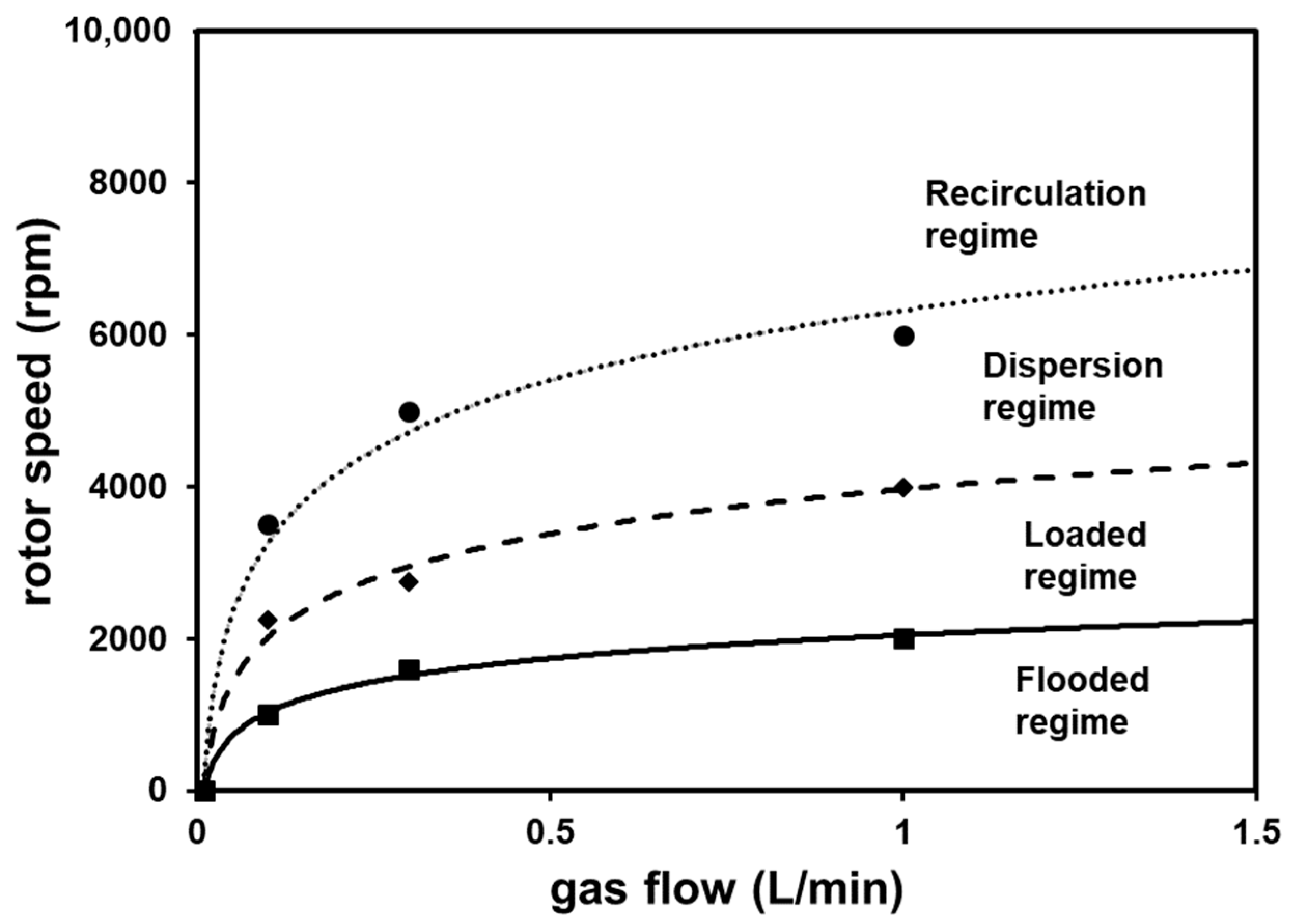
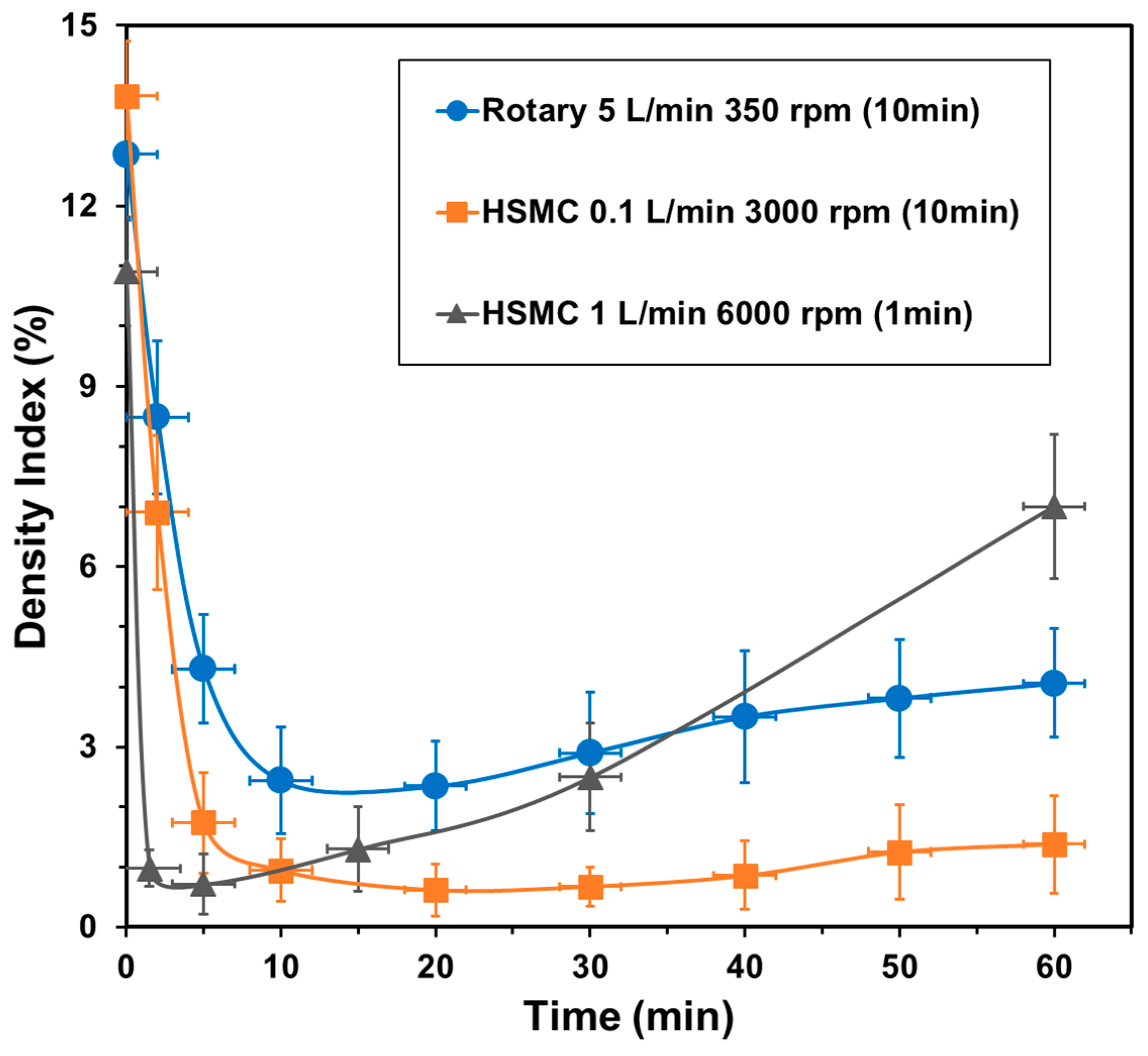
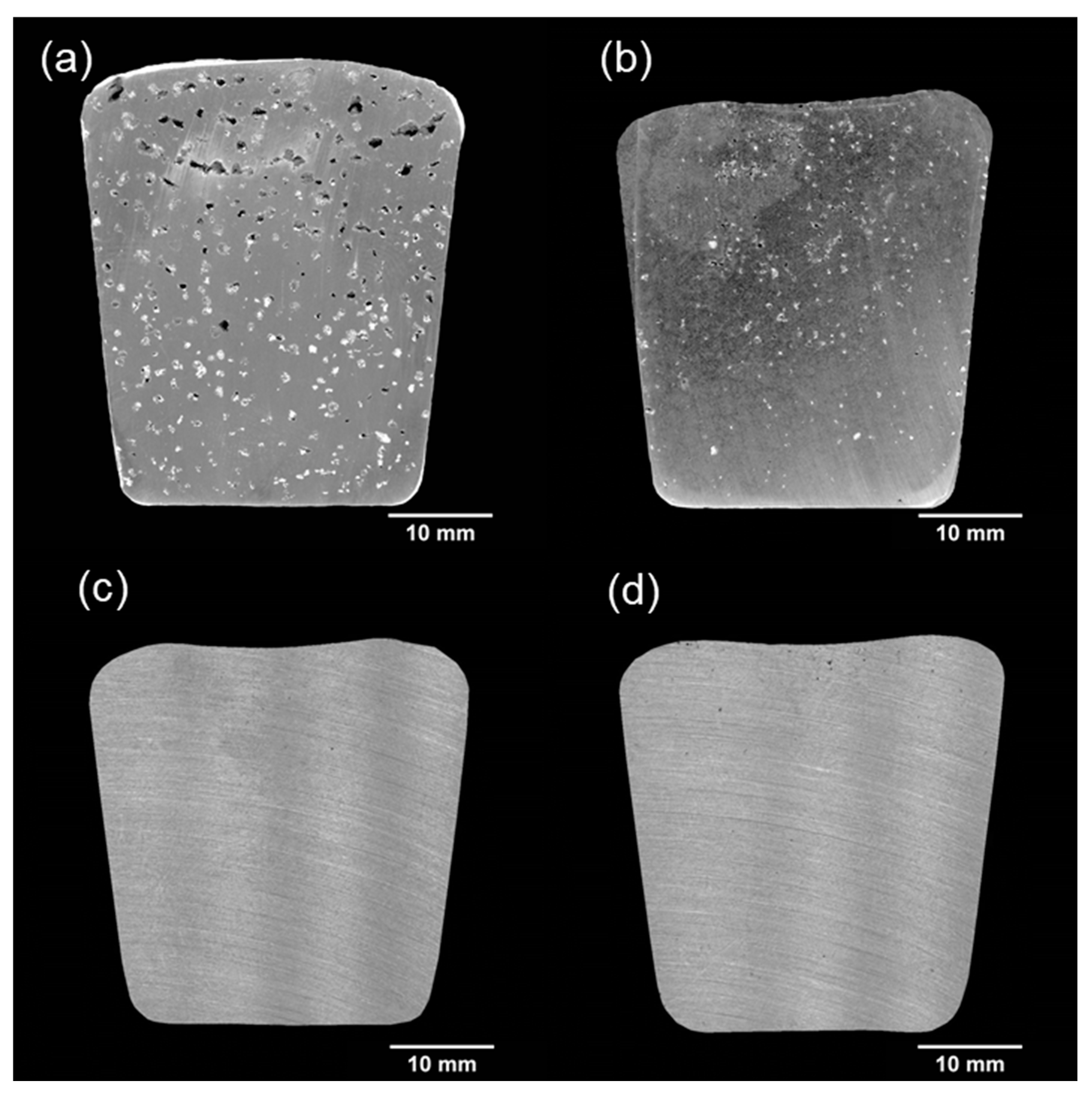
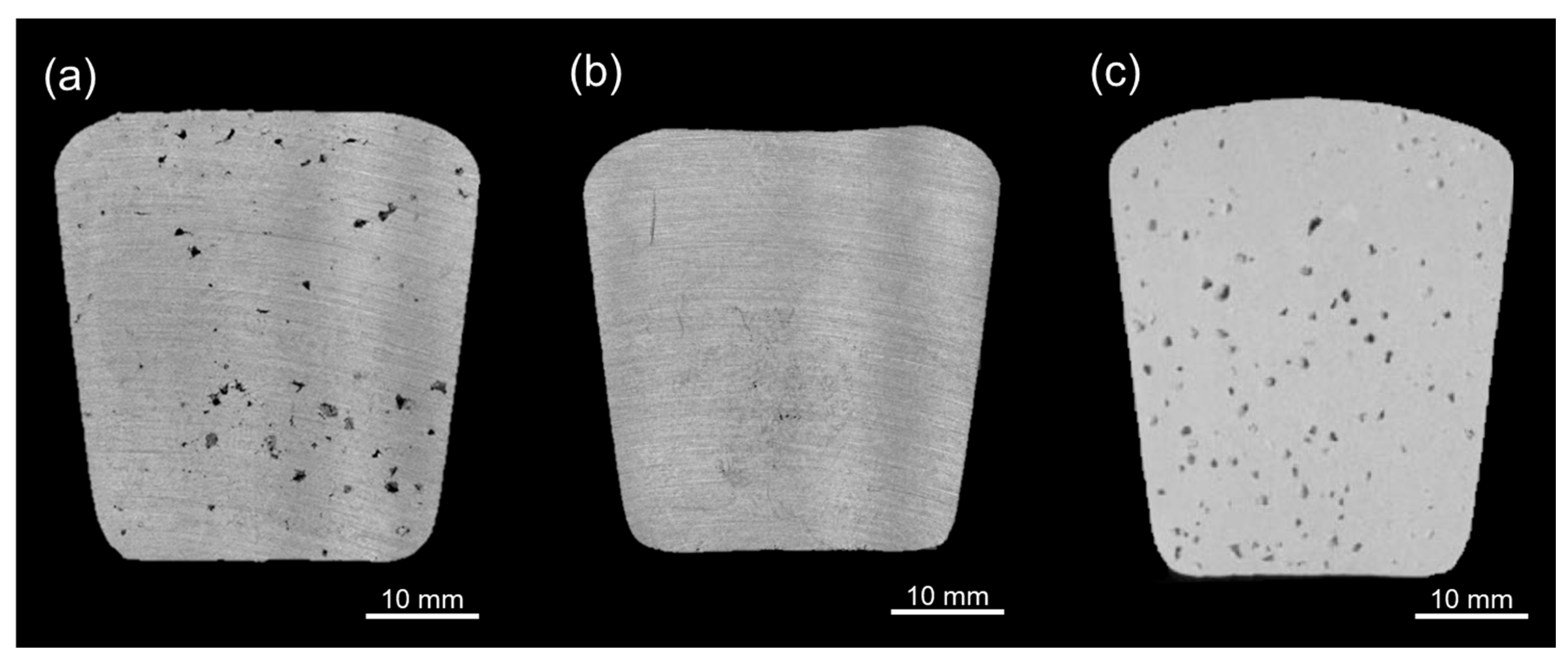
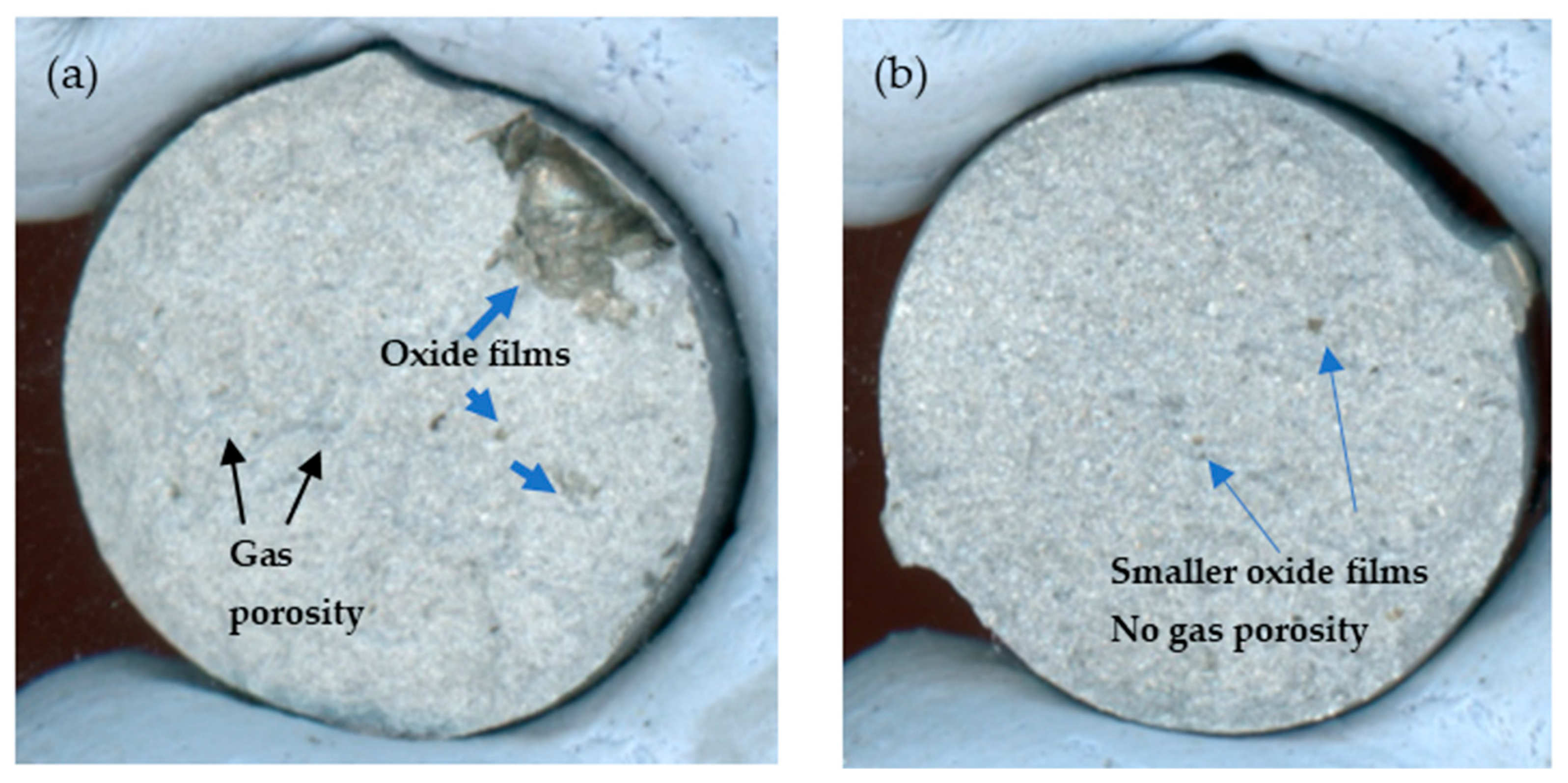
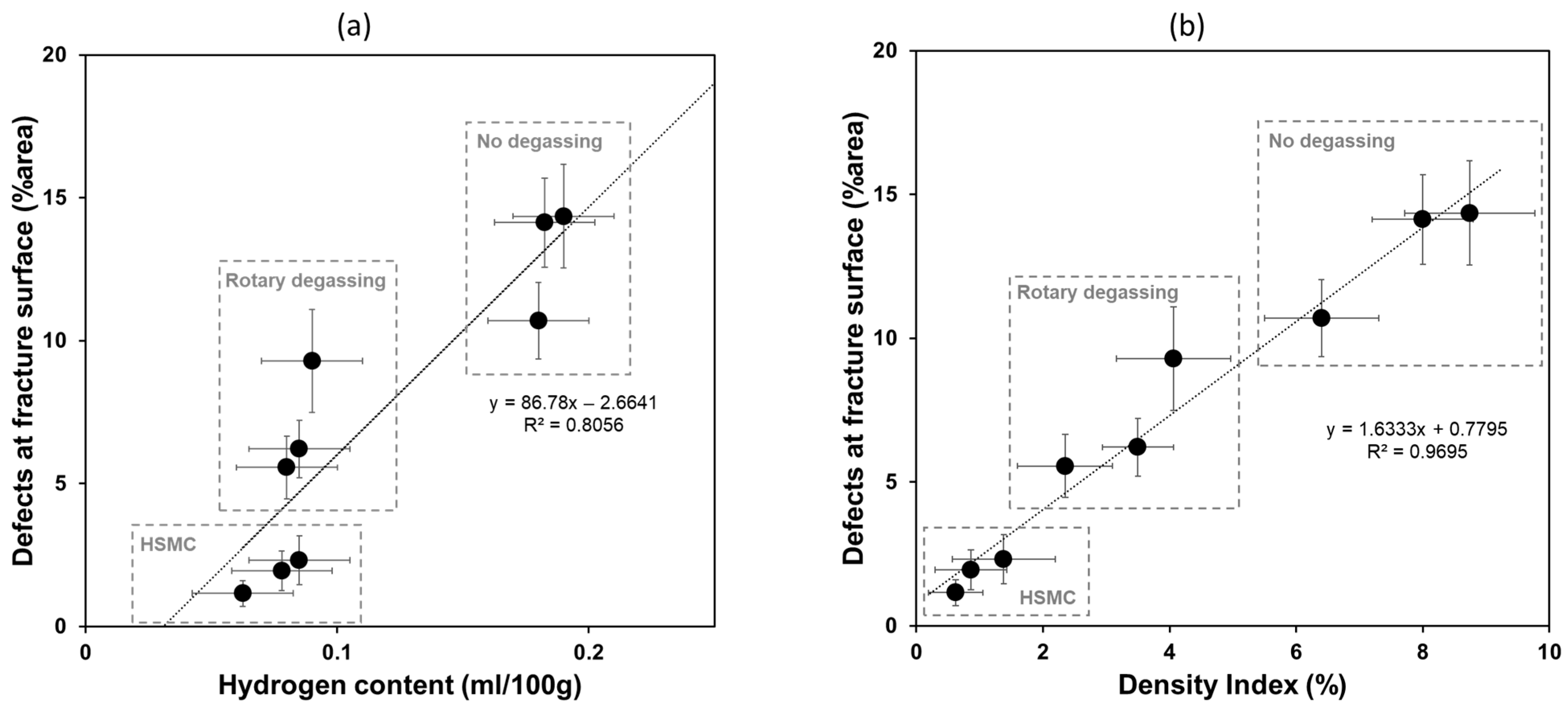
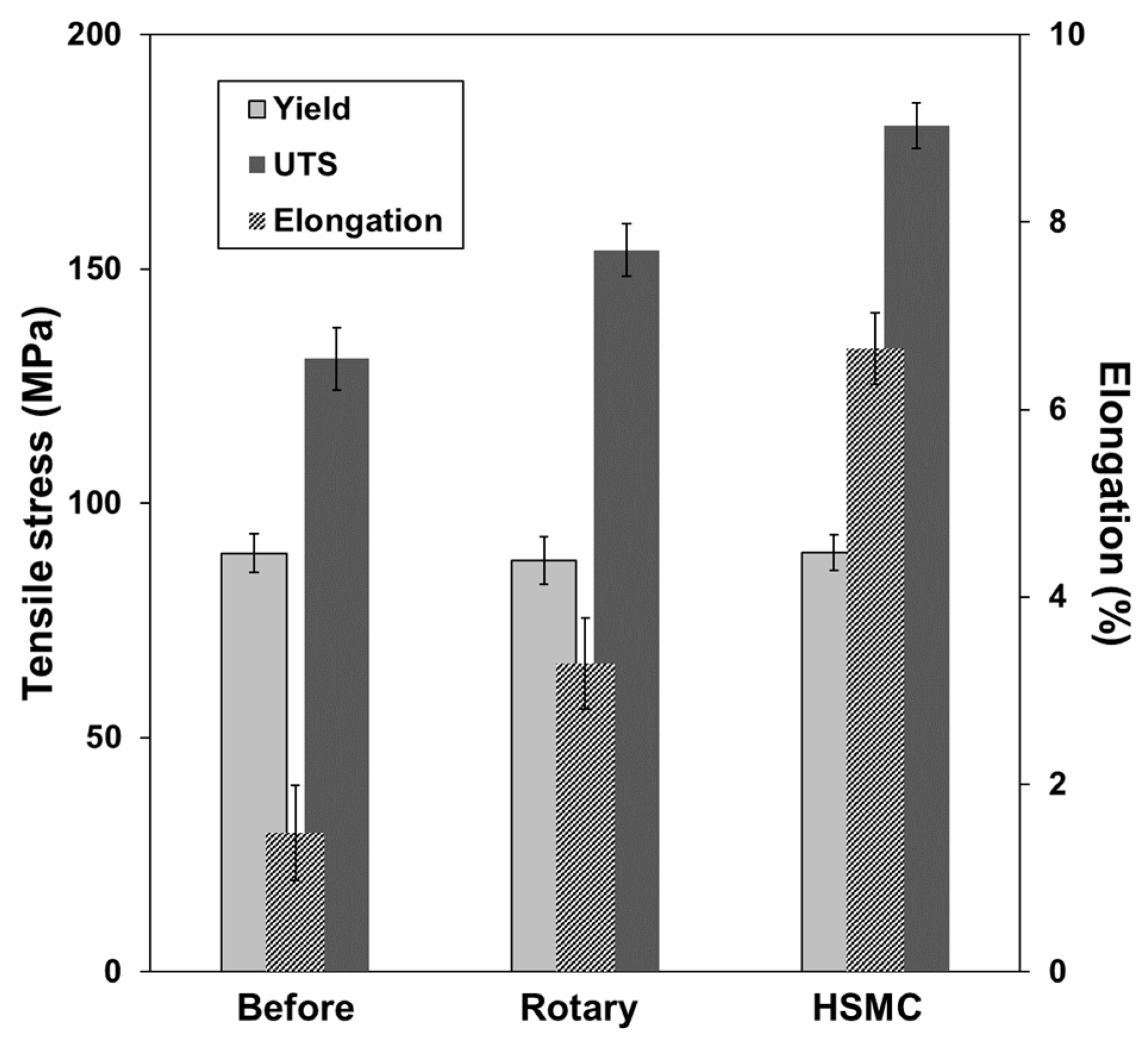

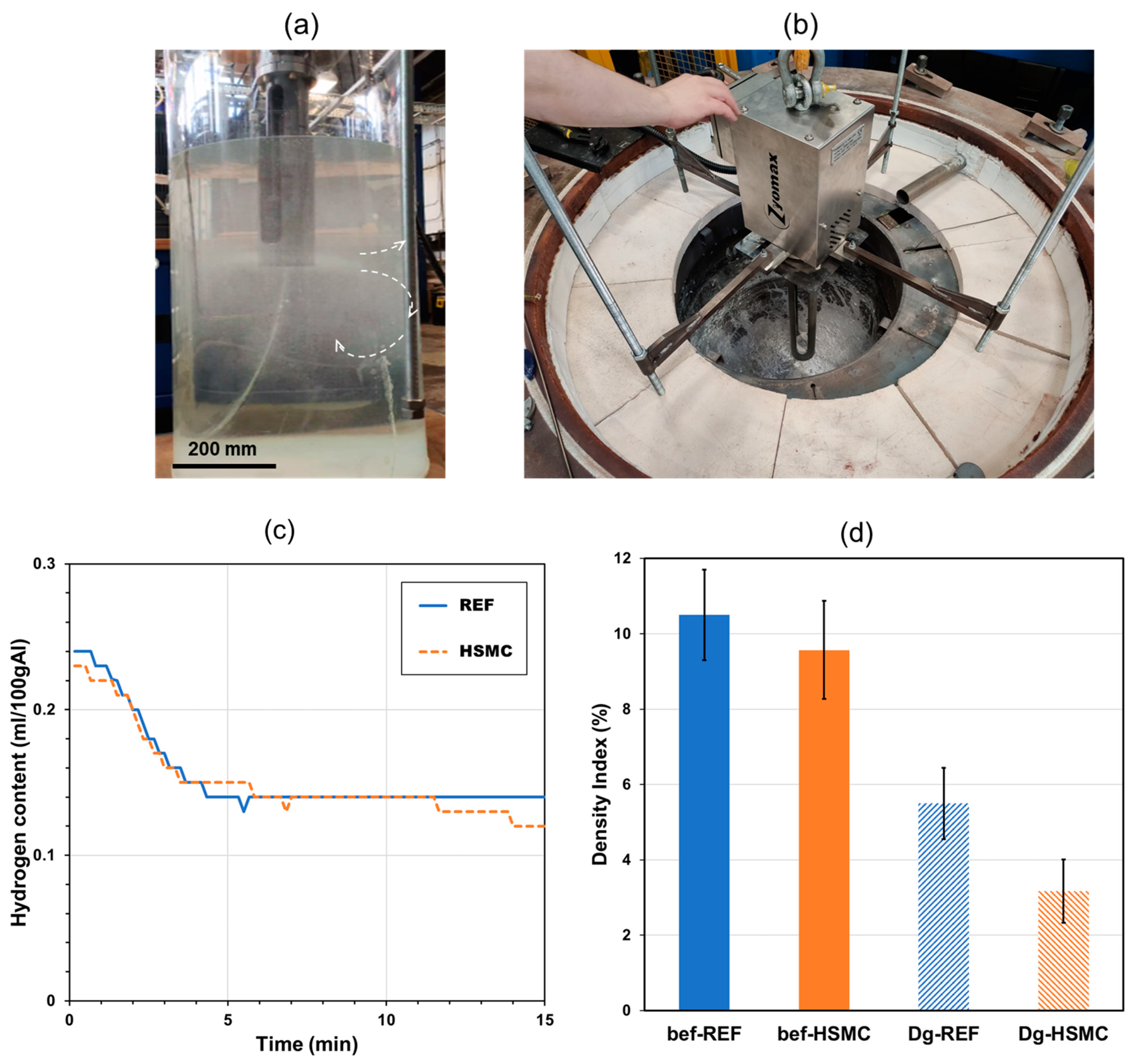
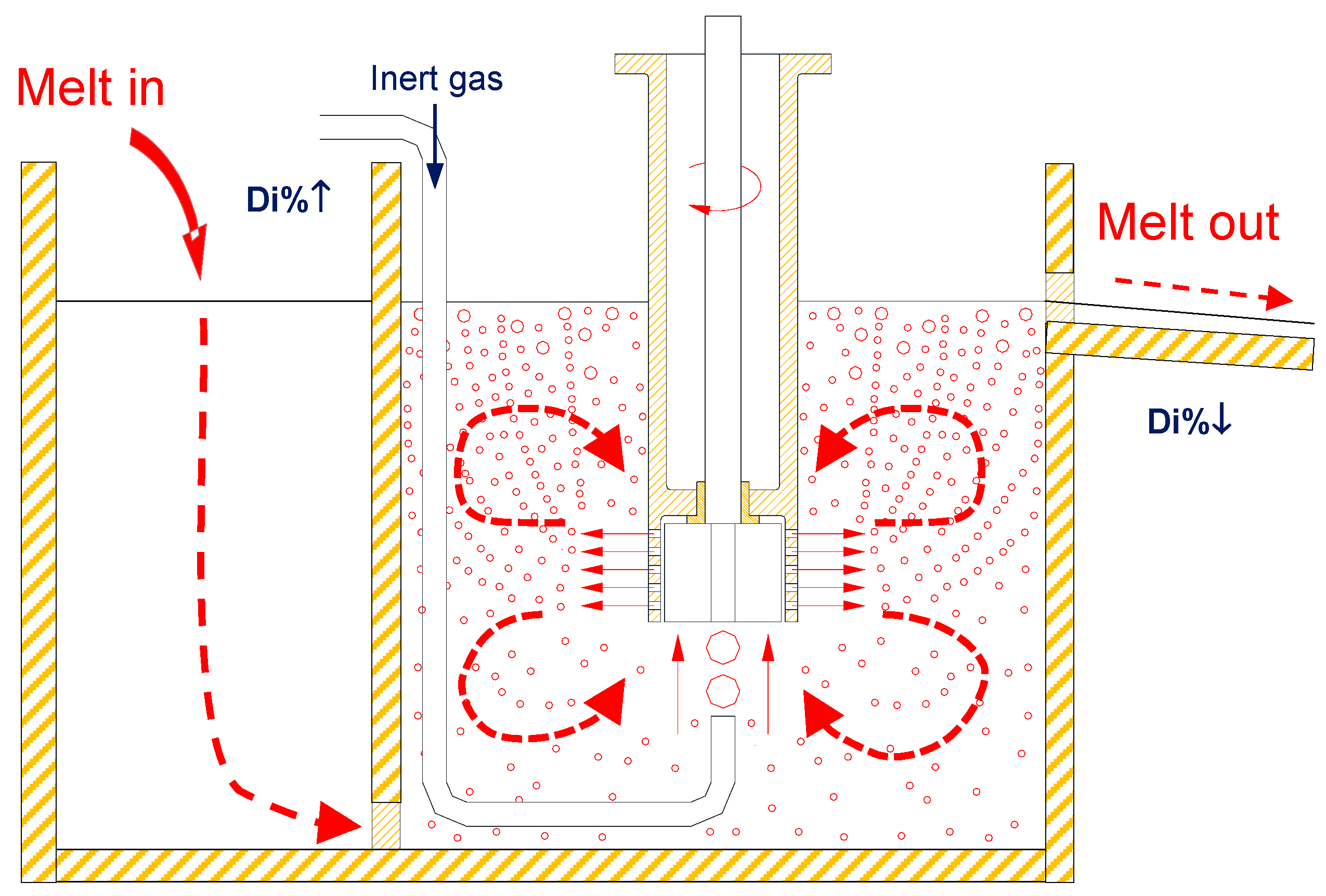


| Trial | Before | After Degassing | After Holding 60 Min |
|---|---|---|---|
| Rotary 5 L/min–350 rpm 1 | 0.38 | 0.08 | 0.10 |
| HSMC 0.1 L/min–3000 rpm 1 | 0.37 | 0.06 | 0.09 |
| HSMC 1 L/min–6000 rpm 2 | 0.35 | 0.06 | 0.11 |
| Rotor Speed (rpm) | Average Pore Diameter (μm) | Pore Density (pores/cm−2) | Bifilm Index (mm) |
|---|---|---|---|
| 0 | 750 ± 150 | 20 ± 4 | 210 ± 20 |
| 500 | 500 ± 80 | 17 ± 5 | 114 ± 22 |
| 1000 | 400 ± 60 | 15 ± 5 | 74 ± 13 |
| 1500 | 300 ± 40 | 12 ± 5 | 68 ± 11 |
| 2000 | 250 ± 30 | 8 ± 3 | 24 ± 7 |
Publisher’s Note: MDPI stays neutral with regard to jurisdictional claims in published maps and institutional affiliations. |
© 2022 by the authors. Licensee MDPI, Basel, Switzerland. This article is an open access article distributed under the terms and conditions of the Creative Commons Attribution (CC BY) license (https://creativecommons.org/licenses/by/4.0/).
Share and Cite
Lazaro-Nebreda, J.; Patel, J.B.; Lordan, E.; Zhang, Y.; Karakulak, E.; Al-Helal, K.; Scamans, G.M.; Fan, Z. Degassing of Aluminum Alloy Melts by High Shear Melt Conditioning Technology: An Overview. Metals 2022, 12, 1772. https://doi.org/10.3390/met12101772
Lazaro-Nebreda J, Patel JB, Lordan E, Zhang Y, Karakulak E, Al-Helal K, Scamans GM, Fan Z. Degassing of Aluminum Alloy Melts by High Shear Melt Conditioning Technology: An Overview. Metals. 2022; 12(10):1772. https://doi.org/10.3390/met12101772
Chicago/Turabian StyleLazaro-Nebreda, Jaime, Jayesh B. Patel, Ewan Lordan, Yijie Zhang, Erdem Karakulak, Kawther Al-Helal, Geoff M. Scamans, and Zhongyun Fan. 2022. "Degassing of Aluminum Alloy Melts by High Shear Melt Conditioning Technology: An Overview" Metals 12, no. 10: 1772. https://doi.org/10.3390/met12101772
APA StyleLazaro-Nebreda, J., Patel, J. B., Lordan, E., Zhang, Y., Karakulak, E., Al-Helal, K., Scamans, G. M., & Fan, Z. (2022). Degassing of Aluminum Alloy Melts by High Shear Melt Conditioning Technology: An Overview. Metals, 12(10), 1772. https://doi.org/10.3390/met12101772










